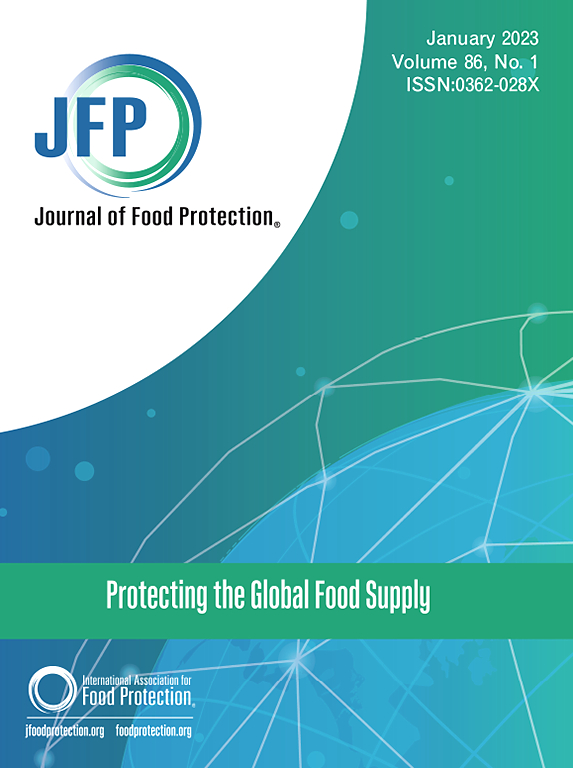Detection of Staphylococcus Enterotoxin sea and seb in Milk Samples by Duplex Droplet Digital PCR
IF 2.8
4区 农林科学
Q3 BIOTECHNOLOGY & APPLIED MICROBIOLOGY
引用次数: 0
Abstract
This study sought to develop a method to accurately and quantitatively measure the staphylococcal enterotoxin genes sea and seb in milk samples using duplex droplet digital polymerase chain reaction (ddPCR). Specific primers and probes were designed for sea and seb. By optimizing the concentrations of primers and probes and the annealing temperature, a duplex ddPCR detection system was established, and the specificity and sensitivity of the method were evaluated. Standard curves were generated using plasmid DNA, pure cultures, and milk samples spiked with Staphylococcus aureus, and a high correlation coefficient (R2 = 0.99) was achieved within the ranges of 1 × 101–1 × 105 copies/μL, 2 × 103–2 × 107 cfu/mL, and 2 × 103–2 × 107 cfu/mL, respectively, for these samples. Using the gradient dilution method with pure cultures and milk samples spiked with S. aureus, the limit of detection (LOD) was 2 × 103 cfu/mL using primers targeting both enterotoxin genes. The test results exhibited good accuracy and repeatability, with three parallel repetitions revealing intra-assay and inter-assay coefficient of variations of <10% and <20%, respectively. When milk samples were spiked with S. aureus at concentrations of 2 × 101 and 2 × 102 cfu/mL, both sea and seb could be detected during the fourth and fifth hours of pre-enrichment, respectively. This study successfully established a duplex ddPCR detection system with high sensitivity and specificity for the quantitative detection of sea and seb in milk samples, thereby permitting the accurate detection of S. aureus directly in milk specimens.
双滴数字PCR检测牛奶样品中的海、seb葡萄球菌肠毒素。
本研究旨在建立一种双液滴数字聚合酶链反应(ddPCR)准确定量测定牛奶样品中葡萄球菌肠毒素基因sea和seb的方法。为sea和seb设计了特异性引物和探针。通过优化引物和探针的浓度以及退火温度,建立了双链ddPCR检测体系,并对该方法的特异性和敏感性进行了评价。用质粒DNA、纯培养物和加入金黄色葡萄球菌的牛奶样品分别生成标准曲线,在1 × 101-1 × 105 copies/μL、2 × 103-2 × 107 cfu/mL和2 × 103-2 × 107 cfu/mL范围内均具有较高的相关系数(R2 = 0.99)。以金黄色葡萄球菌为引物的纯培养物和添加金黄色葡萄球菌的牛奶样品采用梯度稀释法,检测限为2 × 103 cfu/mL。检测结果具有良好的准确性和重复性,3次平行重复显示测定内和测定间变异系数分别为1 × 102 cfu/mL和2 × 102 cfu/mL,在富集前第4和第5小时分别可以检测到sea和seb。本研究成功建立了牛奶样品中sea和seb定量检测的双链ddPCR检测系统,具有较高的灵敏度和特异性,可直接对牛奶样品中的金黄色葡萄球菌进行准确检测。
本文章由计算机程序翻译,如有差异,请以英文原文为准。
求助全文
约1分钟内获得全文
求助全文
来源期刊

Journal of food protection
工程技术-生物工程与应用微生物
CiteScore
4.20
自引率
5.00%
发文量
296
审稿时长
2.5 months
期刊介绍:
The Journal of Food Protection® (JFP) is an international, monthly scientific journal in the English language published by the International Association for Food Protection (IAFP). JFP publishes research and review articles on all aspects of food protection and safety. Major emphases of JFP are placed on studies dealing with:
Tracking, detecting (including traditional, molecular, and real-time), inactivating, and controlling food-related hazards, including microorganisms (including antibiotic resistance), microbial (mycotoxins, seafood toxins) and non-microbial toxins (heavy metals, pesticides, veterinary drug residues, migrants from food packaging, and processing contaminants), allergens and pests (insects, rodents) in human food, pet food and animal feed throughout the food chain;
Microbiological food quality and traditional/novel methods to assay microbiological food quality;
Prevention of food-related hazards and food spoilage through food preservatives and thermal/non-thermal processes, including process validation;
Food fermentations and food-related probiotics;
Safe food handling practices during pre-harvest, harvest, post-harvest, distribution and consumption, including food safety education for retailers, foodservice, and consumers;
Risk assessments for food-related hazards;
Economic impact of food-related hazards, foodborne illness, food loss, food spoilage, and adulterated foods;
Food fraud, food authentication, food defense, and foodborne disease outbreak investigations.
 求助内容:
求助内容: 应助结果提醒方式:
应助结果提醒方式:


